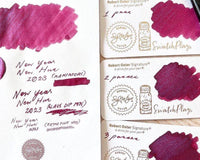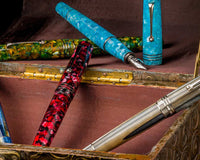If you know a thing or two about gold nibs, then you’ll know that they are designed to be durable and long-lasting. This strength and durability are some of the main reasons fountain pen enthusiasts still invest in gold nibs, among others. Gold is also inherently resistant to corrosion and tarnish, so it retains its appearance and key properties for longer. However, are all gold nibs resistant to tarnish and stain, especially with time? Read on to learn more.
The Gold Standard
Pure, 24-karat gold is indeed highly resistant to tarnish. However, most fountain pen nibs are not made of pure gold. Gold is typically alloyed with other metals, such as copper, silver, and nickel to enhance the nib's durability and writing properties. These alloys, while still providing the desired qualities of a gold nib, are more susceptible to tarnishing.
Some factors that contribute to tarnishing are:
Alloy composition. The specific mix of metals in the gold alloy will determine its resistance to tarnish.
Ink chemistry. Certain inks, particularly those with high iron content or other additives, can accelerate tarnishing.
Environmental factors. Exposure to humidity, pollutants, and even skin oils can contribute to the tarnishing process.
Staining vs. Tarnishing
It’s important to distinguish between staining and tarnishing. Staining is typically caused by ink residue building up on the nib, while tarnishing is a chemical reaction that affects the metal itself. While both can affect the appearance of the nib, they require different cleaning methods.
Preventing Tarnish and Staining
Here are some tips to keep your gold nib looking its best:
• Regular cleaning: After each use, rinse your pen with tepid water to remove ink residue.
• Avoid harsh chemicals: Strong cleaning agents can damage the nib and accelerate tarnishing.
• Proper storage: Store your pen in a dry place away from direct sunlight.
• Ink selection: While it’s difficult to completely avoid inks that might contribute to tarnishing, choosing reputable brands can help minimize the risk.
Removing Tarnish and Staining
If your gold nib does start to show signs of tarnish or staining, then you can gently clean it with a soft, microfiber cloth. Sometimes, what appears as tarnish is simply just other forms of debris, especially on older nibs. Avoid abrasive materials that could scratch the nib. For stubborn tarnish, you might consider using a gentle jeweler’s polishing cloth.
The Beauty of Patina
While tarnishing is often seen as undesirable, some people appreciate the unique character that develops on a gold nib over time. Tarnish is a form of patina, which is essentially corrosion that occurs when metal particles are exposed to oxygen and moisture, causing a dull film to develop on the nib. For some, this can add a vintage aesthetic to your pen. However, if you prefer to maintain the original shine of your nib, regular cleaning and care are essential.
The Bottom Line
In conclusion, while gold fountain pen nibs are generally resistant to tarnish, they are not immune to it. By understanding the factors that contribute to tarnishing and taking proper care of your gold fountain pen nib, you can enjoy its beauty and performance for years to come.
Written by EndlessPens Blogger Ramona Kabigting









